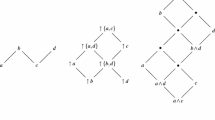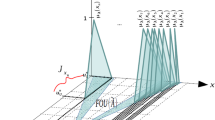Abstract
Fuzzy geometric object modelling has been one of the fundamental tasks in computer graphics. In this paper, we investigated and developed techniques for modelling fuzzy objects based on fuzzy set theory. With the proposed techniques any conventional geometric objects, such as points, lines, triangles, and curved surfaces can all be easily extended as certain kind of fuzzy sets to represent geometric objects with fuzzy boundaries. In addition, experimental results are presented to demonstrate how 3D fuzzy shapes represented in this way can be rendered efficiently and effectively in multiple passes using shader programs running entirely on programmable GPUs.
Access this chapter
Tax calculation will be finalised at checkout
Purchases are for personal use only
Preview
Unable to display preview. Download preview PDF.
Similar content being viewed by others
References
Ricci, A.: A constructive geometry for computer graphics. Computer Journal 16(3), 157–160 (1973)
Rosenfeld, A.: The diameter of a fuzzy set. Fuzzy Sets and Systems 13(6), 241–246 (1984)
Rosenfeld, A.: Fuzzy rectangles. Pattern Recognition Lett. 11, 677–794 (1990)
Rosenfeld, A.: Fuzzy plane geometry: triangles. Pattern Recogn. Lett. 15(12), 1261–1264 (1994)
Buckley, J.J., Eslami, E.: Fuzzy plane geometry i: Points and lines. Fuzzy Sets and Systems 86(2), 179–187 (1997)
Buckley, J.J., Eslami, E.: Fuzzy plane geometry ii: Circles and polygons. Fuzzy Sets and Systems 87(1), 79–85 (1997)
Rosenfeld, A.: Fuzzy geometry: an updated overview. Inf. Sci. 110(3-4), 127–133 (1998)
Kim, T.Y., Han, J.H.: Edge representation with fuzzy sets in blurred images. Fuzzy Sets Syst. 100(1-3), 77–87 (1998)
Zhang, J.L., Pham, B., Chen, Y.P.P.: Modelling and indexing fuzzy complex shapes. In: Proceedings of the IFIP TC2/WG2.6 Sixth Working Conference on Visual Database Systems, Deventer, The Netherlands, pp. 401–415. Kluwer Academic Publishers, Dordrecht (2002)
Li, Q., Griffiths, J.G., Ward, J.: Constructive implicit fitting. Comput. Aided Geom. Des. 23(1), 17–44 (2005)
Dombi, J.: A general class of fuzzy operators, de morgan class of fuzzy operators and fuzziness measures induced by fuzzy operators. Fuzzy Sets and Systems 2, 149–163 (1982)
Hsu, P.C., Lee, C.: The scale method for blending operations in functionally-based constructive geometry. Computer Graphics Forum 22(2), 143–158 (2003)
Pasko, G.I., Pasko, A.A., Kunii, T.L.: Bounded blending for function-based shape modeling. IEEE Computer Graphics and Applications 25(2), 36–44 (2005)
Barthe, L., et al.: Two-dimensional potential fields for advanced implicit modeling operators. COMPUTER GRAPHICS forum 22(1), 23–33 (2003)
Barthe, L., Wyvill, B., Broot, E.D.: Controllable binary CSG operators for “soft objects”. International Journal of Shape Modeling 10(2), 135–154 (2004)
Li, Q.: Smooth piecewise algebraic fuzzy set operations. Technical report, Department of Computer Science, University of Hull (2006)
Li, Q.: Smooth piecewise polynomial blending operations for implicit shapes. Computer Graphics Forum (To appear)
Zadeh, L.: Fuzzy sets. Information and Control 8, 338–353 (1965)
Wang, P.Z. (ed.): Fuzzy Sets and Random Set Falling Shadows. Beijing Normal Univ. Press, Beijing (1985)
Zimmermann, H.J.: Fuzzy Set Theory and Its Applications, 3rd edn. Kluwer Academic Publishers, Boston (1996)
Kaufmann, A., Gupta, M.M.: Introduction to Fuzzy Arithmetic Theory and Application. Van Nostrand Reinhold, New York (1991)
Barthe, L., Gaildrat, V., Caubet, R.: Extrusion of 1d implicit profiles: Theory and first application. International Journal of Shape Modeling 7(2), 179–199 (2001)
Hoffmann, C.M.: Implicit curves and surfaces in CAGD. IEEE Computer Graphics and Appl. 13, 79–88 (1993)
Middleditch, A.E., Sears, K.H.: Blend surfaces for set-theoretic volume modelling systems. In: Proceedings of SIGGRAPH 85, pp. 161–170 (1985)
Rockwood, A.P.: The displacement method for implicit blending surfaces in solid models. ACM Transactions on Graphics 8(4), 279–297 (1989)
Bloomenthal, J., Wyvill, B.: Interactive techniques for implicit modeling. Computer Graphics (1990 Symposium on Interactive 3D Graphics) 24(2), 109–116 (1990)
Pasko, A.A., et al.: Function representation in geometric modeling: concepts, implementation and applications. The Visual Computer 11(8), 429–446 (1995)
Wickerhauser, M.V.: Adapted Wavelet Analysis from Theory to Software. A.K. Peters, Wellesley (1994)
Author information
Authors and Affiliations
Editor information
Rights and permissions
Copyright information
© 2007 Springer-Verlag Berlin Heidelberg
About this paper
Cite this paper
Li, Q., Guo, S. (2007). Fuzzy Geometric Object Modelling. In: Cao, BY. (eds) Fuzzy Information and Engineering. Advances in Soft Computing, vol 40. Springer, Berlin, Heidelberg. https://doi.org/10.1007/978-3-540-71441-5_60
Download citation
DOI: https://doi.org/10.1007/978-3-540-71441-5_60
Publisher Name: Springer, Berlin, Heidelberg
Print ISBN: 978-3-540-71440-8
Online ISBN: 978-3-540-71441-5
eBook Packages: EngineeringEngineering (R0)




